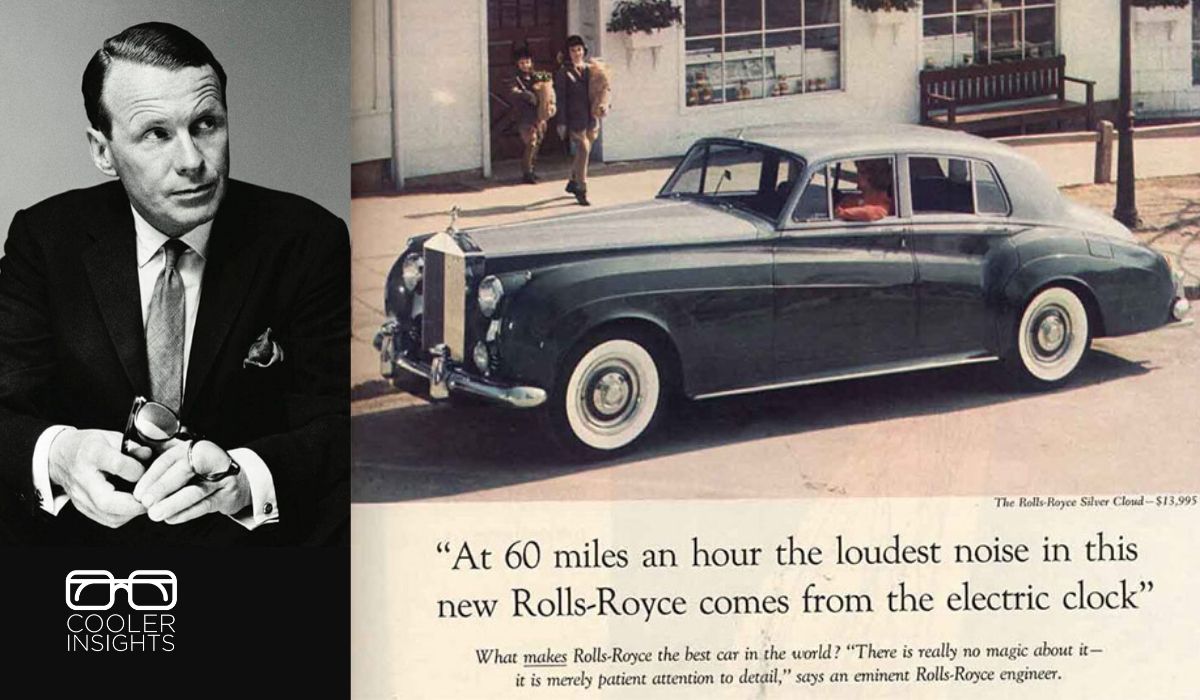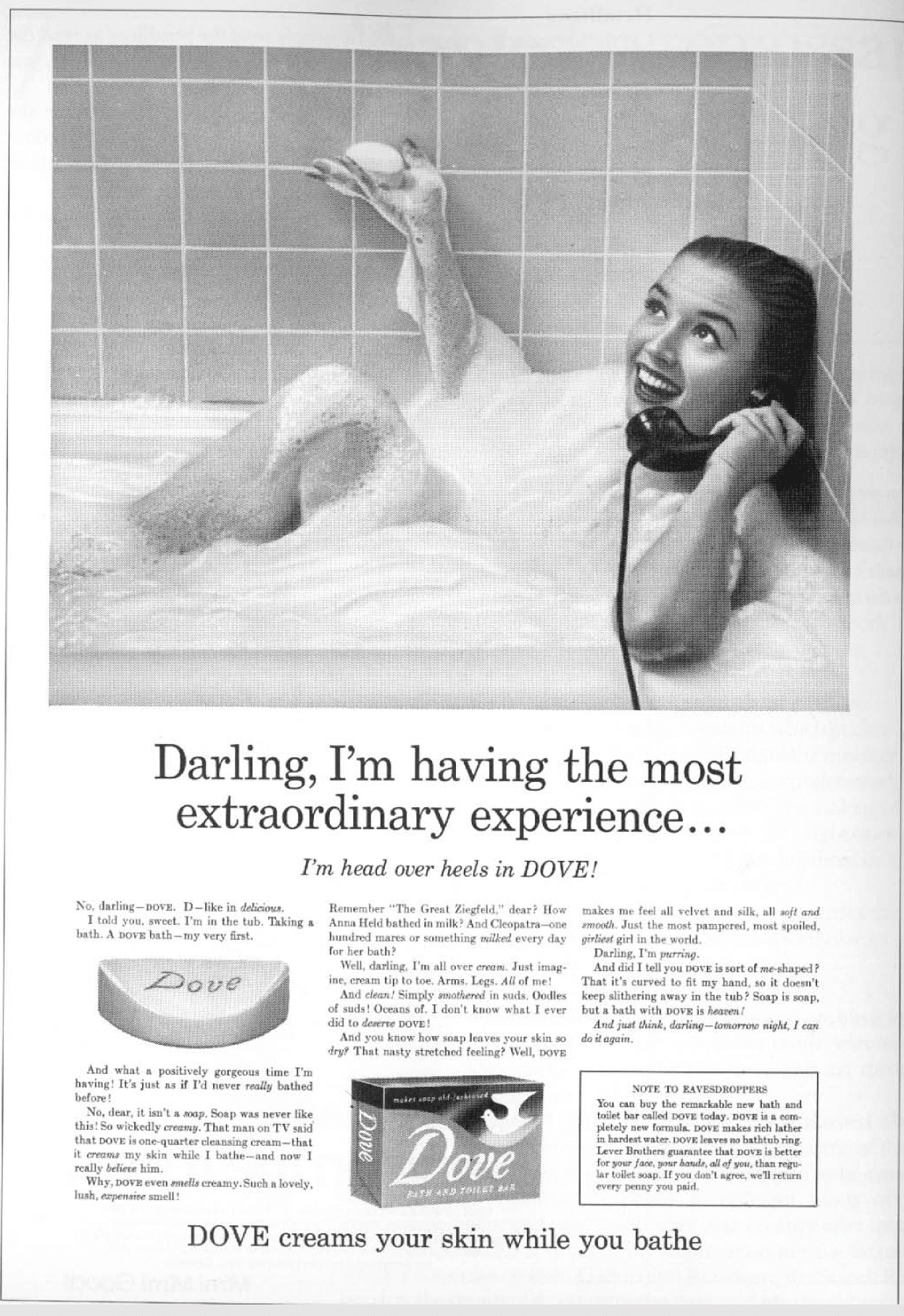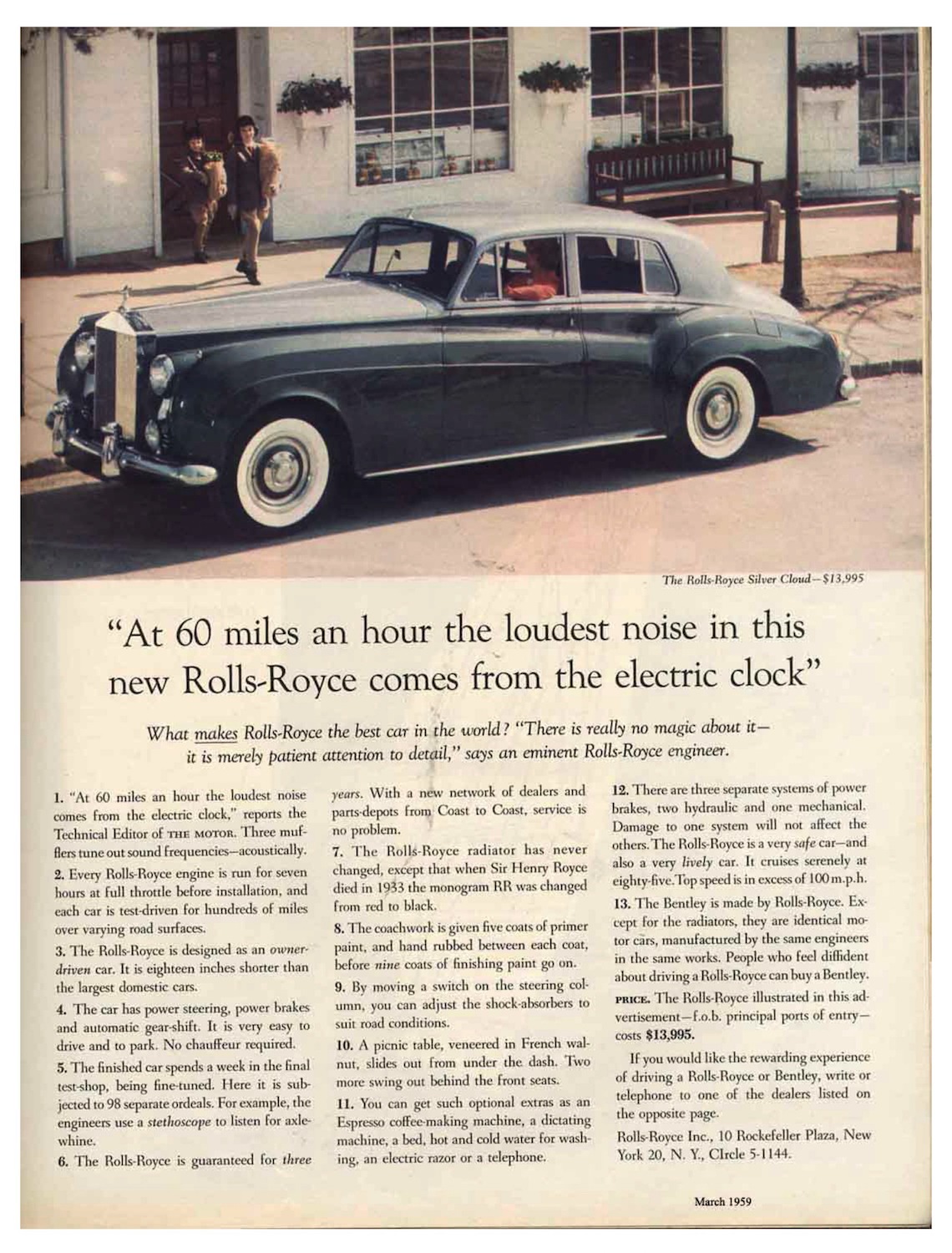
David Ogilvy is a man who needs little introduction.
Famed for starting the global agency Ogilvy & Mather Worldwide (now simply Ogilvy and part of WPP Group), David Ogilvy was the prototypical ad man in the mid 20th century.
A renowned copywriter, his evergreen techniques were used to create successful campaigns which bolstered the fortunes of brands like Rolls Royce, Shell, Lever Brothers, General Foods, and American Express.
Ogilvy was probably best known for crafting what some called the “most famous headline in advertising.” This was for an ad for Rolls-Royce, which read like this:
“At 60 miles an hour the loudest noise in this new Rolls-Royce comes from the electric clock.”
In this article, we will dive into Ogilvy’s copywriting wisdom drawn from his book Ogilvy on Advertising as told on the book The Advertising Solution. These techniques are as relevant for today’s online copywriters as they were back when they were written.
#1 Study Your Product
First, study what you’re supposed to sell and dig out everything you can about your product. Ask yourself these questions:
- What are the features of the product?
- What are its advantages over the competition?
- What are some interesting facts or statistics or ingredients that go into it?
- How can these elements be used effectively in a cohesive manner?
- How does the product appeal to you? Ogilvy often advocated that advertising men should try out the products themselves.
Use the groundwork here to come up with the Big Idea in your online advertising. This is the singular strongest advantage that will stand out among all others.
#2 Study Your Competitors
Next, dive into what your competitors are doing, and see what they’re doing.
Look at their online and offline advertising. Digest the way they craft their copy, and the way they design their visuals.
Ask yourself what their big ideas are in their marketing materials. Why do they appeal to their target audiences? What elements can you copy and adapt for your own social media post or display ad?
#3 Study Your Customers
To know your customers, you should dig deep into how they think, feel and act.
Learn to speak like them. Tune into their language.
Survey your customers and ask them what aspects of the product appeal to them. What kind of product or brand promise will matter most to them?
#4 Develop the Positioning of Your Product
Ogilvy had a simple way of defining the positioning of a product:
What the product does, and who it is for.
Positioning is all about determining who your audience is, what they care about, how your ad would appeal to them, and what benefits you can give to this target audience.
It is about identifying who your best prospect is, and crafting your posts or ads to that specific person.
For example, when Ogilvy first came out with an ad for Dove soap, he positioned it as the perfect cleaner for men’s dirty hands. Over time, however, the found that the better positioning was for Dove to be a moisturising soap for women with dry skin. This better positioning became highly successful and is still used by Dove today.
You can see an example of a Dove ad which Ogilvy did back in the 1960s.

#5 Match with the Right Brand Image
From the Marlboro Man to the curvy Coca-Cola bottle to the swoosh of Nike, every major brand has an image that stands out.
This instantly recognisable image should support the positioning of your brand.
Choose an attractive and authoritative looking figure to represent your brand. Make this person, animal, or object the “hero” of your brand. They can be real or fictitious.
#6 Craft the Big Idea
Famed for his “big idea” concept, Ogilvy often did lots of research before he came up with the “aha” moment when it dawned on him.
The Rolls-Royce ad is a good example. Similarly, he used an old-fashioned bakery wagon pulled by horses for Pepperidge Farm – a baked goods company.
Mine the depths of your knowledge of your product and your customers to develop your “big idea.”
#7 Identify what is “Positively Good”
Instead of trying to prove that everything about your brand is better than your competitor, focus on that one thing (or two things) where you are “positively good.”
Tell your prospects how good you are, and list all your great qualities. Create confidence in the value of your product, and use facts and descriptions to substantiate your claims.
Don’t boast and brag with empty unfounded statements.
#8 Test Your Ads with Data
Avoid reinventing the wheel if a current promotional piece works. However, you should always strive to develop a new ad that out-pulls the current “control” ad that you are doing.
To test your ads, consider doing variations of the following:
- Headlines and intro copy and body copy
- Call To Actions (CTAs) and offers
- Visual images and videos
In short, you should look at your data to determine which version works better. Wherever possible, seek to turn your successful pieces into “control” pieces that you could then compare your future pieces to.
#9 Seek to Create Word-of-Mouth
If possible, make your advertising campaign good enough to enter the popular culture.
Creating buzz can help you to trigger greater Word-Of-Mouth (WOM), and help you to stay on top of a trend and take advantage of your golden moment.
To learn more about how to go viral, read my article here.
#10 Write to Them as Individuals
Most people read your ads or posts when they are alone. Hence, you should communicate like you would to personal friend.
Use conversational language, like you’re talking to them face-to-face. This would mean using the first and second person, ie “me” and “you” when you’re addressing your prospect in your copy.
#11 Simple Words, Short Sentences, and Brief Paragraphs
Ogilvy suggests that your language should not be too difficult for an average person.
He suggests that you “take a bus trip to Iowa, talk to a farmer for a week, then come back by train and talk to your fellow passengers.”
This advice is still as relevant today as it was then.
#12 Don’t Write Essays
Yes, nobody wants to “study” an ad or a post on Facebook or LinkedIn!
Your copy should tell your audience exactly what your product or service does for them, and how it will improve their lives.
Use specifics that make it easy for your readers to picture how they can benefit personally from your offer.
Avoid being philosophical or theoretical – you’re not writing a thesis!
#13 Use Storytelling in Your Ad
Craft your copy in the shape of a story. Using storytelling techniques can help your ad to stand out significantly.
For example, Ogilvy cited this highly popular ad used for Zippo lighters with the following headline:
The Amazing Story of a Zippo That Worked After Being Taken from the Belly of a Fish
And of course, John Caples classic ad with the headline:
They Laughed When I Sat Down at the Piano…But When I Started to Play!
Stories are not only more memorable – they also grab your audience’s attention, and help them to connect with your product and service.
(More on social media storytelling here.)
#14 Avoid Obscure Analogies and Superlatives
In Ogilvy’s book, using difficult analogies may result in misunderstanding.
His cited that if you show a picture of a Rembrandt and say, “Just as a Rembrandt is a masterpiece, so too is our product,” you may mislead your reader into thinking that you’re selling Rembrandt prints.
Superlatives that are unsubstantiated are bad too – nobody will believe you when you claim that “We’re simply the best in the world!”
#15 Use Testimonials If You Have Them
Customer testimonials and success stories are useful if they are taken from somebody that is similar to your target audience for the ads.
#16 Include Your Price in Your Advertisement
According to Ogilvy, most people already have a fairly good idea of the cost of an item. Hence, this may be useful in instances where the market price is already well established.
However, this may sometimes not be possible for customised services like consulting, training or agency services. In these cases, asking the reader to contact you for more information may be the way forward.
#17 Longer Copy Outweighs Shorter Copy
From numerous split-tests done, Ogilvy claimed that longer copy usually outsells shorter copy.
What’s more important, however, is to ensure that your copy is interesting enough for people to want to read it.
#18 Use the Following Headline Writing Strategies
Finally, consider the following strategies when you write your headline for web pages, landing pages, emails, blog articles or other online platforms.
Promise a Benefit: Readers are four-times more likely to read headlines that promise a benefit than one without.
Read Reader’s Digest: Ogilvy suggests that the way Reader’s Digest write their titles are ingenious,
Sell Your Product in Your Headline: According to Ogilvy, headlines have to carry important information on the product itself as five times as many readers will look at your headline compared to the rest of your ad.
Include Product Name in Headline: If you neglect to do so, you may miss the 80 percent of readers who only read the headline and not the rest of the copy.
Make Your Headline News: Write your headline like a news story about your product – this can be about when it will be launched, improvements made, or new ways to use them.
Use Attention Grabbing Words: Don’t be afraid of crafting words like “amazing,” “introducing,” “now,” “for the first time,” “completely new,” and “suddenly” in your headline.
Be Helpful: “How to” headlines have always worked well.
Call Out Your Audience: This is another technique that can work well, for example “Mothers, are you tired of working 3 jobs a day?”
Headlines Long and Short: Use as many words as you need to get the job done.
Test Your Headlines: Just as you should for the rest of your post or ad.
Use Specific Information: Avoid using generalities in your headlines, and give actual percentages or other figures, eg “On average, our trainees get a job 2 months after the course.”
“Headlines in quotation marks increase recall”: … by as much as 28 percent it seems. So try them out!
Local Advertising? Put name of city in headline: When people see that you are providing an offer on something local that concerns them, they will pay more attention to them.
Avoid tricks, puns, obscure references: Doing so may actually confuse your readers and be counter-productive.
In short, Ogilvy’s advice on headlines is that “your headline should telegraph what you want to say.”
Conclusion
As a wiry long-time copywriter – albeit mostly on online platforms like websites, display ads, Facebook, LinkedIn, Twitter, and Instagram – I found the age-old wisdom of David Ogilvy refreshing and relevant.
While some of the platforms may have changed over the years – from newspapers and magazines to social networks and websites – their principles still stand on solid ground.
Which of these digital copywriting secrets will you start applying? And what is your favourite copywriting tip?
PS – You can read Ogilvy’s legendary Rolls-Royce ad below, and also see how he wrote this in this swipe file.

